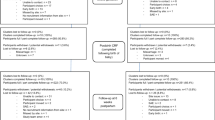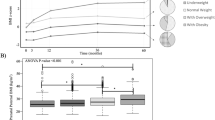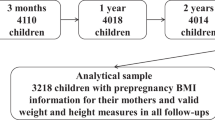Abstract
Background
The study aimed to evaluate how maternal pre-pregnant body mass index (BMI) impacts participant recruitment and retention.
Methods
Participants were enrolled in a longitudinal study between 30 and 36 weeks of pregnancy as having normal weight (pre-pregnant BMI ≥ 18.5 and <25 kg/m2) or obesity (pre-pregnant BMI ≥ 30.0 kg/m2). Recruitment channels included Facebook, email, newspaper, phone calls, radio advertisements, flyers, and word-of-mouth. The stages of recruitment included eligibility, consent, and completion. Pearson’s chi-square tests were used to evaluate the relationship between BMI and enrollment outcomes.
Results
Recruitment yielded 2770 total prospective participants. After screening, 141 individuals were eligible, 83 consented, and 60 completed the study. Facebook was the most successful method for identifying eligible pregnant patients with obesity, while a higher percentage of participants recruited through word-of-mouth and flyers consented to the study. Pre-pregnant BMI was significantly associated with the stage of recruitment completed by the participant (p = 0.04), whereby individuals eligible for the study with obesity were less likely to consent and complete study visits.
Conclusion
We demonstrated that maternal obesity was significantly associated with enrollment outcomes in a longitudinal birth cohort study. This study showed that pre-pregnancy BMI influenced study participation. Therefore, tailored recruitment strategies to enhance the recruitment and enrollment of individuals with obesity in maternal-infant health research may be necessary.
This is a preview of subscription content, access via your institution
Access options
Subscribe to this journal
Receive 12 print issues and online access
$259.00 per year
only $21.58 per issue
Buy this article
- Purchase on SpringerLink
- Instant access to full article PDF
Prices may be subject to local taxes which are calculated during checkout


Similar content being viewed by others
Data availability
Data used in this study cannot be shared publicly in order to protect participant confidentiality. All requests to review data that may include potential subject and/or patient identifiers will be reviewed by our University’s Privacy Office and Institutional Review Board to ensure adequate protection of subjects. Any dissemination approved by the University will be reviewed by a University honest data broker to ensure appropriate legal and ethical compliance with regulatory agencies. Requests for data should be addressed to DJL at the University of Florida (djlemas@ufl.edu).
References
Wharton S, Lau DCW, Vallis M, Sharma AM, Biertho L, Campbell-Scherer D, et al. Obesity in adults: a clinical practice guideline. CMAJ. 2020;192:E875–91.
Bicocca MJ, Mendez-Figueroa H, Chauhan SP, Sibai BM. Maternal obesity and the risk of early-onset and late-onset hypertensive disorders of pregnancy. Obstet Gynecol. 2020;136:118–27.
Sun Y, Shen Z, Zhan Y, Wang Y, Ma S, Zhang S, et al. Effects of pre-pregnancy body mass index and gestational weight gain on maternal and infant complications. BMC Pregnancy Childbirth. 2020;20.
Rasmussen S, Irgens L, Espinoza J. Maternal obesity and excess of fetal growth in pre-eclampsia. BJOG. 2014;121:1351–8.
Bloomberg M. Maternal obesity and risk of postpartum hemorrhage. Obstet Gynecol. 2011;118:561–8.
Machado LS. Cesarean section in morbidly obese parturients: practical implications and complications. North Am J Med Sci. 2012;4:13–18.
Chang E, Hafner H, Varghese M, Griffin C, Celemente J, Islam M, et al. Programming effects of maternal and gestational obesity on offspring metabolism and metabolic inflammation. Sci Rep. 2019;9.
Nicholas LM, Morrison JL, Rattanatray L, Zhang S, Ozanne SE, Mcmillen IC. The early origins of obesity and insulin resistance: timing, programming and mechanisms. Int J Obes. 2016;40:229–38.
Desai M, Jellyman JK, Han G, Beall M, Lane RH, Ross MG. Maternal obesity and high-fat diet program offspring metabolic syndrome. Am J Obstet Gynecol. 2014;211:237.e1–13.
Freeman DJ. Effects of maternal obesity on fetal growth and body composition: implications for programming and future health. Semin Fetal Neonatal Med. 2010;15:113–118.
Driscoll AK, Gregory ECW. Increases in prepregnancy obesity: United States, 2016-2019. 2020.
Cardel MI, Atkinson MA, Taveras EM, Holm J-C, Kelly AS. Obesity treatment among adolescents. JAMA Pediatr. 2020;174:609.
Nuako A, Tu L, Campoverde Reyes KJ, Chhabria SM, Stanford FC. Pharmacologic treatment of obesity in reproductive aged women. Curr Obstet Gynecol Rep. 2023;12:138–46.
Falcone V, Stopp T, Feichtinger M, Kiss H, Eppel W, Husslein PW, et al. Pregnancy after bariatric surgery: a narrative literature review and discussion of impact on pregnancy management and outcome. BMC Pregnancy Childbirth. 2018;18.
Thangaratinam S, Rogozińska E, Jolly K, Glinkowski S, Duda W, Borowiack E, et al. Interventions to reduce or prevent obesity in pregnant women: a systematic review. Health Technol Assess. 2012;16.
Downs DS, Savage JS, Rivera DE, Pauley AM, Leonard KS, Hohman EE, et al. Adaptive, behavioral intervention impact on weight gain, physical activity, energy intake, and motivational determinants: results of a feasibility trial in pregnant women with overweight/obesity. J Behav Med. 2021;44:605–21.
Baruth M, Schlaff RA, Deere S, Walker JL, Dressler BL, Wagner SF, et al. The feasibility and efficacy of a behavioral intervention to promote appropriate gestational weight gain. Matern Child Health J. 2019;23:1604–12.
Lim S, O’Reilly S, Behrens H, Skinner T, Ellis I, Dunbar JA. Effective strategies for weight loss in post-partum women: a systematic review and meta-analysis. Obes Rev. 2015;16:972–87.
Lemas DJ, Wright L, Flood-Grady E, Francois M, Chen L, Hentschel A, et al. Perspectives of pregnant and breastfeeding women on longitudinal clinical studies that require non-invasive biospecimen collection—a qualitative study. BMC Pregnancy Childbirth. 2021;21.
Xu K, Hsiao CJ, Ballard H, Chachad N, Reeder CF, Shenkman EA, et al. Peripartum women’s perspectives on research study participation in the OneFlorida Clinical Research Consortium during COVID-19 pandemic. J Clin Transl Sci. 2023;7:1–22.
Coleman-Phox K, Laraia BA, Adler N, Vieten C, Thomas M, Epel E. Recruitment and retention of pregnant women for a behavioral intervention: lessons from the maternal adiposity, metabolism, and stress (MAMAS) study. Prev Chronic Dis. 2013;10.
Pekarsky C, Skiffington J, Leijser LM, Slater D, Metcalfe A. Social media recruitment strategies to recruit pregnant women into a longitudinal observational cohort study: usability study. J Med Internet Res. 2022;24:e40298.
Knight B, Wyatt K. Barriers encountered when recruiting obese pregnant women to a dietary intervention. Nursing. 2010;106:20–2.
van der Zande ISE, van der Graaf R, Hooft L, van Delden JJM. Facilitators and barriers to pregnant women’s participation in research: a systematic review. Women Birth. 2017;31:350–61.
Meldgaard M, Jensen AL, Johansen AD, Maimburg RD, Maindal HT. Health literacy and related behaviour among pregnant women with obesity: a qualitative interpretive description study. BMC Pregnancy Childbirth. 2022;22.
Wilcox S, Liu J, Addy CL, Turner-McGrievy G, Burgis JT, Wingard E, et al. A randomized controlled trial to prevent excessive gestational weight gain and promote postpartum weight loss in overweight and obese women: Health In Pregnancy and Postpartum (HIPP). Contemp Clin Trials. 2018;66:51–63.
Waring ME, Simas TAM, Oleski J, Xiao RS, Mulcahy JA, May CN, et al. Feasibility and acceptability of delivering a postpartum weight loss intervention via Facebook: a pilot study. J Nutr Educ Behav. 2018;50:70–4.
Larose JG, Guthrie KM, Lanoye A, Tate DF, Robichaud E, Caccavale LJ, et al. A mixed methods approach to improving recruitment and engagement of emerging adults in behavioural weight loss programs. Obes Sci Pract. 2016;2:341–54.
Corsino L, Lin P-H, Batch BC, Intille S, Grambow SC, Bosworth HB, et al. Recruiting young adults into a weight loss trial: report of protocol development and recruitment results. Contemp Clin Trials. 2013;35:1–7.
Morrison Z, Gregory D, Thibodeau S, Copeland J. Ouch! Recruitment of overweight and obese adolescent boys for qualitative research. Qual Rep. 2012;17:1–17.
Cui Z, Seburg EM, Sherwood NE, Faith MS, Ward DS. Recruitment and retention in obesity prevention and treatment trials targeting minority or low-income children: a review of the clinical trials registration database. Trials. 2015;16.
Nguyen B, McGregor KA, O’Connor J, Shrewsbury VA, Lee A, Steinbeck KS, et al. Recruitment challenges and recommendations for adolescent obesity trials. J Paediatr Child Health. 2012;48:38–43.
Gerards SM, Dagnelie PC, Jansen MW, De Vries NK, Kremers SP. Barriers to successful recruitment of parents of overweight children for an obesity prevention intervention: a qualitative study among youth health care professionals. BMC Fam Pract. 2012;13:37.
Frew ON, Saint-Victor SS, Isaacs MB, Kim S, Swamy GK, Sheffield JS, et al. Recruitment and retention of pregnant women into clinical research trials: an overview of challenges, facilitators, and best practices. Clin Infect Dis. 2014;59:S400–7.
Chin Feman SP, Nguyen LT, Quilty MT, Kerr CE, Nam BH, Conboy LA, et al. Effectiveness of recruitment in clinical trials: an analysis of methods used in a trial for irritable bowel syndrome patients. Contemp Clin Trials. 2008;29:241–51.
Milo Rasouly H, Wynn J, Marasa M, Reingold R, Chatterjee D, Kapoor S, et al. Evaluation of the cost and effectiveness of diverse recruitment methods for a genetic screening study. Genet Med. 2019;21:2371–80.
Burroughs AR, Visscher WA, Haney TL, Efland JR, Barefoot JC, Williams RBJ, et al. Community recruitment process by race, gender, and SES gradient: lessons learned from the Community Health and Stress Evaluation (CHASE) study experience. J Community Health. 2003;28:421–37.
Frandsen M, Thow M, Ferguson SG. The effectiveness of social media (Facebook) compared with more traditional advertising methods for recruiting eligible participants to health research studies: a randomized controlled clinical trial. JMIR Res Protoc. 2016;5:161.
Liu J, Wilcox S, Wingard E, Burgis J, Schneider L, Dahl A. Strategies and challenges in recruiting pregnant women with elevated body mass index for a behavioral lifestyle intervention. Womens Health Rep. 2020;1:556–565.
Tierney S, Butterfield C, Stringer E, Fox J, McGowan LF. Difficulties in recruiting pregnant women with eating or weight issues. Br J Midwifery. 2010;18:717–23.
Daniels LA, Wilson JL, Mallan KM, Mihrshahi S, Perry R, Nicholson JM, et al. Recruiting and engaging new mothers in nutrition research studies: lessons from the Australian NOURISH randomised controlled trial. Int J Behav Nutr Phys Act. 2012;9:129.
Davis DL, Raymond JE, Clements V, Adams C, Mollart LJ, Teate AJ, et al. Addressing obesity in pregnancy: the design, feasibility of an innovative intervention in NSW, Australia. Women Birth. 2012;25:174–80.
Nicholson LM, Schwirian PM, Klein EG, Skybo T, Murray-Johnson L, Eneli I, et al. Recruitment and retention strategies in longitudinal clinical studies with low-income populations. Contemp Clin Trials. 2011;32:353–62.
Chang M-W, Brown R, Nitzke S. Participant recruitment and retention in a pilot program to prevent weight gain in low-income overweight and obese mothers. BMC Public Health. 2009;9:424.
Puhl RM. What words should we use to talk about weight? A systematic review of quantitative and qualitative studies examining preferences for weight‐related terminology. Obes Rev. 2020;21.
Acknowledgements
We would like to acknowledge the research team for their dedicated recruitment efforts. The funders had no role in study design, data collection and analysis, decision to publish, or preparation of the manuscript.
Funding
This work was supported by the National Institute of Diabetes and Digestive and Kidney Diseases [K01DK115632] and the University of Florida Clinical and Translational Science Institute [UL1TR001427]. The content is solely the responsibility of the authors and does not necessarily represent the official views the University of Florida’s Clinical and Translational Science Institute or the National Institutes of Health.
Author information
Authors and Affiliations
Contributions
All authors designed research (project conception, development of overall research plan, and study oversight); YG and MH analyzed data and performed statistical analysis; DJL, EFG, YG, FH and KX interpreted data findings; DJL, EFG, YG, and KX drafted the initial manuscript; all authors provided critical revision of the manuscript; DJL and FH had primary responsibility for final content.
Corresponding author
Ethics declarations
Competing interests
FANH reports consulting fees from WW Inc., outside the scope of the submitted work.
Ethics approval and consent to participate
The data for this study were approved by the Institutional Review Board of the University of Florida (IRB201601899).
Additional information
Publisher’s note Springer Nature remains neutral with regard to jurisdictional claims in published maps and institutional affiliations.
Supplementary information
Rights and permissions
About this article
Cite this article
Heeren, F.A.N., Himadi, M., Flood-Grady, E. et al. Recruitment and retention of participants with obesity into a longitudinal birth cohort: the Breastfeeding and Early Child Health (BEACH) study. Int J Obes 49, 93–100 (2025). https://doi.org/10.1038/s41366-024-01625-0
Received:
Revised:
Accepted:
Published:
Issue date:
DOI: https://doi.org/10.1038/s41366-024-01625-0



